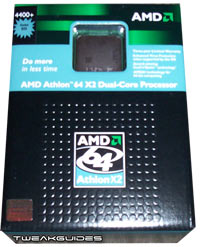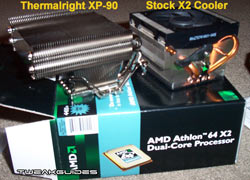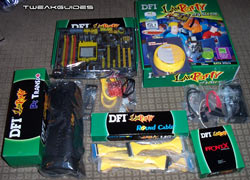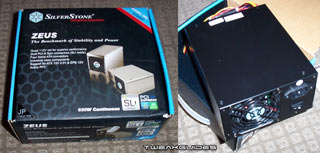Hardware Confusion
[Page 4] The Decisions I Made and Why
Having had an initial version of this article on my site for a while, listing my old and new system specifications, I've already received a fair few emails asking my why in particular I've decided to purchase these particular components. Questions like "Why did you go Dual Core when it's unnecessary?" or "Why get a 7800GTX so soon?" Below are my reasons, and some tips I believe are useful in choosing these types of components for your system.
Note: I've tried to spell out most of the terminology used below, however if in doubt refer to my TweakGuides Tweaking Companion for more definitions/explanations, as well as doing a quick search on good 'ol Google. Sorry but if I explained everything in minute detail the article would be 30 pages long.
CPU
My choice: AMD Athlon 64 X2 4400+ Dual-core CPU
The CPU is the heart of any PC and a critical component. A poor CPU choice can cripple a machine for any task it needs to be put to. There is an industry rule called Moore's Law which paraphrased states that CPU technology will double every 2 years. This is due to the number of transistors which can fit onto integrated circuits of a certain size. At the moment CPUs are reaching a GHz limit on the current IC sizes, and thus to overcome this limitation, CPU manufacturers are finding new ways of obtaining performance improvements without resorting to pure GHz increases. Typically this involves such steps as increasing the cache sizes on the CPUs themselves, adding features like HyperThreading, and the most revolutionary of all in recent times: Dual Core Technology.
My old Pentium 4 2.66GHz was running along just fine, and is still not a major performance bottleneck. I had been quite lucky that this CPU had lasted over 2 years without any problems. But when I saw that dual core technology was coming up, I decided to take the leap straight away. If you examine the current dual core implementations, the AMD X2 chips are far and away both technically and practically the better performing dual cores vs. Intel's Pentium D offerings, particularly for gaming.
In choosing an AMD X2 4400+, I chose a CPU which is based on the latest AMD 64-bit CPU core and has 1MB of L2 cache (vs. 512KB of L2 for the 4200+ and the 4600+), just like the top of the range X2 4800+. Basically the X2 4400+ is identical to an X2 4800+ but is only 200MHz slower. Price-wise the X2 4400+ is almost half the price of the X2 4800+, substantially cheaper than the X2 4600+, and only a touch more expensive than the X2 4200+. It's the obvious price/performance choice in the AMD dual core stakes and is in high demand right now, particularly given supply shortages by AMD. The Intel Pentium D's are proving to be worse performing in many respects, particularly for gaming purposes. They produce more heat and have higher power usage to boot, though the lower-end Pentium D's do cost a bit less. I made the choice to invest a bit more into the superior product in this case.
See the Benchmarks & Real World Usage section for more details of why I went to dual, and how it compares to single core in everyday usage.
CPU Cooling
My choice: Thermalright XP-90 + High Speed Fan
The CPU cooler can be a hard component to choose. There are so many different models of coolers around, it can seem so annoying that you might just opt for the stock cooling which comes with your CPU. To be honest the latest CPUs from Intel and AMD both come with decent heatsink and fan coolers, so it's not critical that you buy a separate CPU cooler. However it can pay to spend a few extra bucks and find a slightly better unit as extra insurance against those times when your system is under a lot of stress, such as gaming on a hot summer's day, or when overclocking. A lot of people crash during games without realising it's due to excess heat in their system - see the Coolermaster Stacker case further below for more details of how I keep my whole system cool.
My decision to get the XP-90 was based on wanting something which is cheap, silent, not particularly difficult to set up (i.e. no water cooling or phase-change cooling), and lightweight. The Thermalright XP-90 heatsink and fan meets all of these criteria, and in particular although I found other models which may provide even better cooling (such as the XP-90C - the copper version of this cooler, or the XP-120), I skipped on them because of their weight and/or size. If you think about it, a large heavy cooler hanging on a 90 degree angle on your motherboard is not something I consider beneficial. Nor is a cooler which takes up a lot of real estate - it may cool your CPU well but what about all the heat it pushes onto your other components because of its closer proximity to them.
Importantly the XP-90 can be purchased with a low-RPM, heat-controlled 'high speed' fan. This is very important, since the biggest impact of a CPU cooler is the amount of noise it makes in your system. Sometimes a noisy cooler at full revs is enough to drive you crazy with its high-pitched variable whining. The XP-90's larger fan spins at around 1000 to 1700RPM (versus ~4,000 - 5,000RPM for a stock cooler), thus moving more air, more quietly. The fan is also heat-controlled, meaning it will drop to under 1,000RPM in cooler conditions. These were the major reason why I decided to install the XP-90 instead of the stock cooler.
Motherboard
My choice: DFI Lanparty NForce4 SLI-DR
The motherboard is almost as critical as the CPU. Think about it - everything in your system plugs into the motherboard. If you buy a bad motherboard your entire system can be bottlenecked. Even more important is the consideration for future upgrades - the motherboard needs to be able to accommodate these, otherwise you will have to buy a new motherboard if you want to upgrade anything in your system.
The CPU choice you make automatically limits your motherboard choices, since particular CPUs require certain CPU socket interfaces on the motherboard. For example, in my case the AMD X2 chips all come in Socket 939 formation, hence I had to buy a motherboard based on Socket 939 which is also known to support dual core CPUs (with an appropriate BIOS update). However there are usually a range of performance/feature choices for motherboards within a certain socket interface type. Your main concern should be for the performance of the motherboard/CPU combo in various tests in reviews. Don't worry as much about hyped-up features such as LAN, RAID, Wi-FI, bright neon colors, etc. if you're not really going to use them.
In my case, I guess I decided to lash out and based on opinions from respected overclockers and system enthusiasts I bought the top-of-the-line DFI Lanparty nForce4 SLI-DR motherboard because of its excellent performance and legendary features. Many of the additional features of this board are somewhat wasted on me, because aside from the standard Nvidia RAID controller I don't have need of Gigabit LAN, multiple SATA ports, and the 'overclockability' of the board. However one of the best-performing chipsets (nForce4 SLI), the latest hard drive controller (SATA-II), the latest graphics interface (PCI-E), the fact that it supports SLI, and DFI's reputation for quality and performance convinced me to spend a bit more for the board to cover me in terms of current performance, future-proofing and upgradeability.
By all accounts this motherboard is finicky and has its fair share of problems, particularly when tweaking the seemingly endless BIOS options and/or upgrading to one of the almost daily beta BIOSes, but given I'm a tweaker at heart, I was willing to put up with these quirks. At least I went into it knowing full well what I was getting into.
Update: I am using the new Official 623-3 BIOS to ensure optimal performance and compatibility with the X2 CPU. This is a good, stable and optimized BIOS and is recommended for all DFI NF4 SLI users. I also use only one USB device (my wireless keyboard/mouse combo) because two or more USB devices can cause some conflicts on this (and most) motherboards. Finally, I connect my Netcomm NB5 Ethernet router to the built-in Nvidia Network Controller, rather than the Marvell LAN connection.
Power Supply
My choice: Silverstone 650W PSU
One of the most overlooked components of a modern PC, people often believe a power supply unit (PSU) is just something which, although necessary, doesn't have any major impact either way. Therefore they usually just settle for the unit which comes with their case (typically a cheap 350-400W unit), and if they have to choose one separately, they pick the cheapest one with a high wattage.
Well in my case the PSU was a tough choice, because I know just how important they are. In particular when you have a system loaded with energy-hungry devices you definitely need the wattage, especially if you're considering using SLI in the future. Two power-hungry high-end graphics cards on one motherboard really need the juice. But far more important than just the wattage is the need to have stable voltages. The cheaper your PSU, the more likely you're going to have large fluctuations in voltages on the different rails when under load, and thus the greater the chance that when your system is under intensive use you will experience a crash. Of course it's very difficult to diagnose a PSU-related crash, unless you are actually tracking the voltages dynamically, but I see a lot of issues people have which are eventually put down to their low wattage and/or relatively unstable PSU voltages. Don't skimp on the PSU.
In my case again, for future-proofing, to ensure that if I use SLI or just in case I had several more components, and to meet the needs of a dual core CPU, a 650W PSU like the Silverstone which is specifically designed for SLI has enough power, stability and connectors to accommodate all my needs. I can't take credit for finding this unit however - I chose it based entirely on advice from a respected enthusiast, otherwise I may have overlooked it because the brand is unfamiliar to me.
The next page continues my component choice descriptions.




